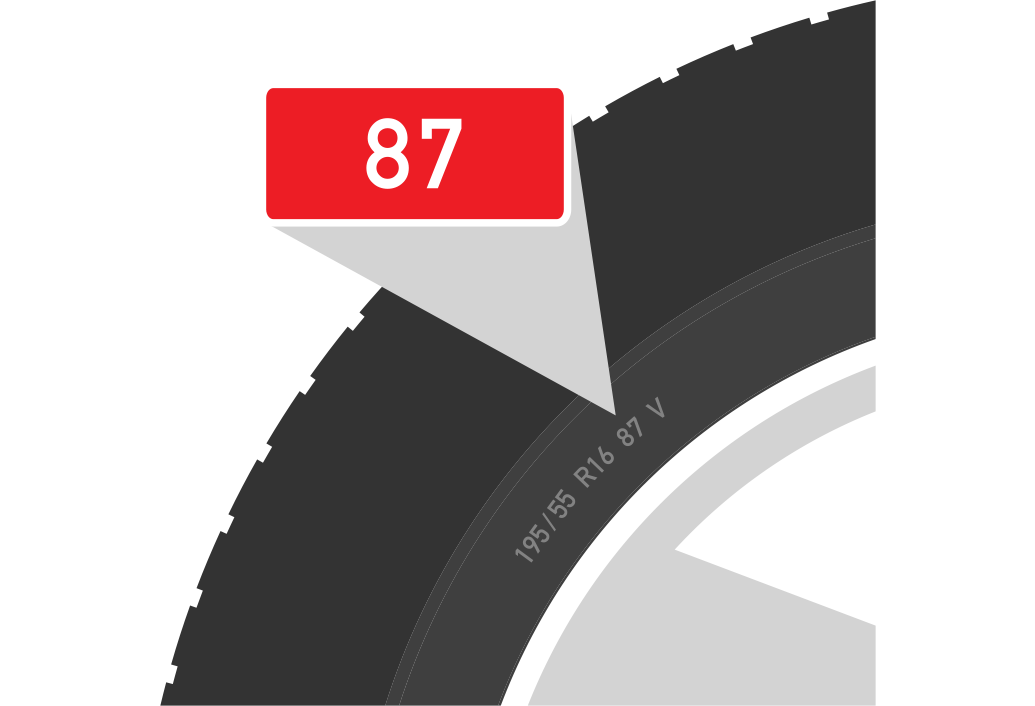
The tyre load index (also known as the load capacity index, tyre load rating or tyre hire load index) identifies the maximum load capacity of a tyre, i.e. the absolute carrying capacity. You will find this information on your tyres. But how is this number calculated?
Tyre load capacity: Calculator for the maximum load
If you would like to go on holiday with a packed car or help someone move, it is important to know how much weight your tyres can carry. A tyre is not designed for loads of any size. That's why it is important that you know and do not exceed the load capacity of your tyres. The tyre load capacity is not so well known. The figure indicates the maximum possible load of a tyre. To calculate the load your rims and car can carry, in theory you can just take a look at your vehicle registration or the tyre sidewall. You will find the tyre labelling there.
The two- to three-digit number in the penultimate position stands for the tyre load capacity of your tyres. However, these indicators do not reveal anything about the permissible load in kilograms. So this is a useless indicator in everyday life. It is easier to calculate the tyre load rating using our load index table for tyres. There you can find the maximum load in kilograms for the respective rating. For a tyre code with the digits 195/55 R16 87 V, the 87 in the penultimate position is relevant: This represents a tyre load rating of 87, i.e. a load capacity of 545 kilograms.

Load capacity index of tyres: Preventing exceedance

It is a legal requirement that the indicated tyre load capacity is not exceeded. In addition, you avoid the risk of tyre damage. Your vehicle speed and the air pressure in the tyres also influence the relative indicator of load capacity. Driving at high speed and with heavy loads exerts forces that put a high amount of stress on the tyres. If the load becomes too great, the tyres can become damaged. Other factors often come into play here, such as the tyre lifespan. But one thing is certain: By staying within your tyres’ load capacity, you can virtually eliminate damage caused by excess loads.
The tyre air pressure is important when it comes to the tyre load capacity. The load capacity of your vehicle gradually decreases as the air pressure reduces. In turn, the load capacity increases as the air pressure increases. However, the recommended guide value should not be exceeded as this can change driving behaviour. In principle, the following applies: Increasing the air pressure by 0.1 bar increases the tyre load index of the tyre by one value.
Load capacity index: The factors to be considered
The information in the load index table for tyres is based on an assumed tyre pressure of 2.5 bar. However, experience shows that the value is not adhered to in many cars. The pressure is only seldom checked, with the result that tyres are simply not adequately filled. Inadequate tyre pressure has a negative effect on driving behaviour.
Check the air pressure of your tyres on a regular basis and increase it above the target value by a few tenths of a bar as necessary. This way, you will increase your tyre load capacity and guarantee safe driving behaviour.
Load capacity calculator for your tyres
Checking the table is the easiest and surest way to calculate the load capacity index of your tyres. However, it is possible to find out the next highest values without a table if the permissible weight for a rating is already known. Nevertheless, deviations cannot be ruled out. For this reason, we recommend using our table to calculate the exact load capacity of your tyres.

Tyre load index: Summer vs winter tyres
There is not necessarily a deviation between the load index of a summer tyre and that of the winter tyre. However, if the tread depth or diameter differs, the tyre probably has a different load capacity index. In winter, tyres have to meet more weather challenges than in summer. Whether on snow or ice, driving becomes more difficult and braking distances become longer. This means that: Higher loads mean that drivers have less control over their cars. So take the different load capacities seriously and ensure maximum safety.
| Load Index | Load in kg | Load Index | Load in kg | Load Index | Load in kg | Load Index | Load in kg |
| 62 | 265 | 79 | 437 | 96 | 710 | 113 | 1150 |
| 63 | 272 | 80 | 450 | 97 | 730 | 114 | 1180 |
| 64 | 280 | 81 | 462 | 98 | 750 | 115 | 1215 |
| 65 | 290 | 82 | 475 | 99 | 775 | 116 | 1250 |
| 66 | 300 | 83 | 487 | 100 | 800 | 117 | 1285 |
| 67 | 307 | 84 | 500 | 101 | 825 | 118 | 1320 |
| 68 | 315 | 85 | 515 | 102 | 850 | 119 | 1360 |
| 69 | 325 | 86 | 530 | 103 | 875 | 120 | 1400 |
| 70 | 335 | 87 | 545 | 104 | 900 | 121 | 1450 |
| 71 | 345 | 88 | 560 | 105 | 925 | 122 | 1500 |
| 72 | 355 | 89 | 580 | 106 | 950 | 123 | 1550 |
| 73 | 365 | 90 | 600 | 107 | 975 | 124 | 1600 |
| 74 | 375 | 91 | 615 | 108 | 1000 | 125 | 1650 |
| 75 | 387 | 92 | 630 | 109 | 1030 | 126 | 1700 |
| 76 | 400 | 93 | 650 | 110 | 1060 | ||
| 77 | 412 | 94 | 670 | 111 | 1090 | ||
| 78 | 425 | 95 | 690 | 112 | 1120 |
Tyre load rating table
Related Topics
-
 2023/03/31Tyre pressureFor your safety, comfort and the longevity of your tyres, it’s important that you check your tyre pressures regularly.Read more
2023/03/31Tyre pressureFor your safety, comfort and the longevity of your tyres, it’s important that you check your tyre pressures regularly.Read more -
 2023/03/31Cornering forceThere’s more to tyre design than you might think. Engineers need to consider safety, fuel efficiency, wear and tear and performance - while being fully aware of all the forces that affect handling.Read more
2023/03/31Cornering forceThere’s more to tyre design than you might think. Engineers need to consider safety, fuel efficiency, wear and tear and performance - while being fully aware of all the forces that affect handling.Read more -
 2023/03/31Tread depthIt’s important that you know how to check your tyres’ tread depth. After all, the tread depth affects handling and provides grip with the road surface. The deeper it is, the more grip you’ll have.Read more
2023/03/31Tread depthIt’s important that you know how to check your tyres’ tread depth. After all, the tread depth affects handling and provides grip with the road surface. The deeper it is, the more grip you’ll have.Read more